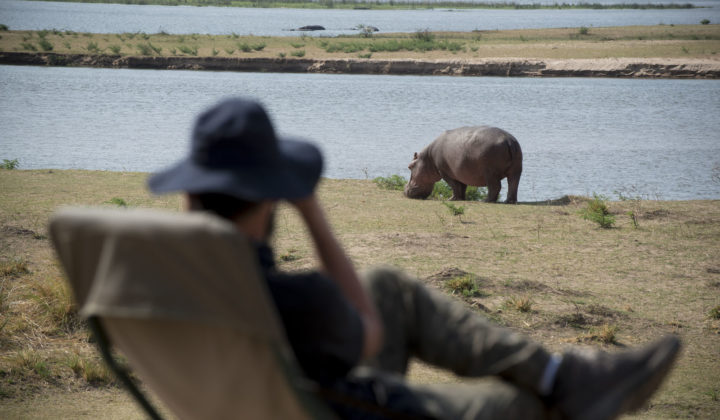Mana Pools National Park
Situated in northern Zimbabwe, Mana Pool National Park lies on the southern banks of the Zambezi River. On the northern banks, across from Mana Pool National Park, lies Lower Zambezi National Park in Zambia. The park is a visual paradise with four permanent water pools, which were carved out by the former channels of the Zambezi River and are the national park’s major water source during the dry season.
The word Mana comes from Shona – a dialect of the Bantu language – and means ‘Four.’ The reserve’s four main pools are Chisambuk Pool, Long Pool, Chine Pool, and Main Pool. Mana Pools National Park is also known for its rich and diverse wildlife. However, the national park has a difficult history fraught with hunting. Let’s see how history has treated Mana Pool National Park’s wildlife.
The History of Mana Pools National Park
Experts have found evidence of pottery shards south of Chine Pool and other regions within the Mana Pool National Park. The Zambezi Valley was once flush with wildlife, but over the years numbers have drastically decreased, mainly due to hunting followed by poaching. However, over the last 30 years, stringent conservation efforts have resulted in an overpopulation of elephants in Zimbabwe overall and in 2021, it was estimated to be 100,000.
- Early 20th century: Marcel Mytton, a prolific 20th-century hunter,chose to hunt elephants in Karoi and Chinhoyi region, moving away from the Zambezi because he knew he couldn’t find any elephants in the Lower Zambezi.
- 1952: A large portion of the current park region was reserved as a non-hunting area.
- 1963: Mana Pool was gazetted as a non-hunting game reserve. Following its proclamation, the locals were displaced and forced to move to the areas south of the Zambezi escarpment. However, the displacement proved to be beneficial for the wildlife.
- 1975: Mana Pools gained the status of national park.
- 1984: Mana Pools National Park, in conjunction with the Chewore Safari Rea and Sap Safari Area, was inscribed in the UNESCO World Heritage Site as a single landmark. Due to their declining numbers, it was rare to spot elephants in the Mana Pools during the latter part of the 20th century.
- 2001-2014: Over the years, the elephant population in Zimbabwe grew (to around 80,000) but faced another hurdle in the form of poachers. These illegal hunters caused a 40% decline in the Mana Pools and Zambezi Valley’s elephant population over a period of 13 years, from 18,000 to 11,400.
- 2013: On 3rd January 2013, Mana Pools was given the status of Ramsar Wetland.
- 2016-2019: Investigation officers and Park Rangersworked tirelessly to stop the poaching in the region, resulting in a significant decline in poaching in the Lower Zambezi.
- 2020: It was announced no elephants had been poached for twelve months in Mana Pools and the surrounding Zambezi Valley in Zimbabwe.
- 2021: In 2021, Mana Pools had around 12,000 elephants.
Wildlife in Mana Pools National Park
Mana Pools National Park has an abundance of hippos and crocodiles, which can be seen in the waters of the pools as well as the Zambezi River.
Thanks to conservation efforts, Mana Pools National Park also has a large population of African elephants. Other commonly spotted game animals include buffaloes, zebras, impalas, elands, waterbuck, and kudu.
Mana Pool National Park is home to predators such as lions, leopards, cheetahs, hyenas, and wild dogs. Visitors who want to see lions and leopards might have to head out to the south of Mana Pools National Park, while Mana Pools is also one of the few African parks to have a decent population of wild dogs. Based on the present data, there are at least 90 wild dogs living here.
According to the Ramsar site information service, Mana Pools National Park is home to over 450 species of resident and migratory birds. Visitors can spot extraordinary birdlife such as the blue-cheeked bee-eater, southern carmine bee-eater, Lilian’s lovebird, Peter’s twinspot, and white-backed night heron.
Mana Pool and Zambezi River Safaris
Boat and canoe safaris offer an attractive wildlife-viewing alternative to game drives. As you cruise down the river, spot pods of hippos wallowing in the water, Nile crocodiles lazing on the sand banks as well as other wildlife drinking at the water’s edge and superb bird life.
When to Visit Mana Pools National Park
For an exceptional wildlife viewing experience, the best time to visit Mana Pools National Park is from June to October during the dry season. The thinning vegetation and dried-up water sources force the animals to gather around the pools and Zambezi River, making them easier to spot. During most of the wet season, from January to March, the accommodation near Mana Pools National Park is closed while muddy roads can be a serious hazard and are often inaccessible.
The wet season attracts migratory bird species from northern Africa and Europe. Birdwatchers can plan a trip for November or March when rainfall is below 52 mm.
Login to your account
Register as a traveller if you are looking for deals
Register as a travel partner if you offer amazing safaris
You May Also Be Interested In...

Victoria Falls
The largest single sheet of falling water in the world (with a height of 355 feet (108 m) and width of 5,604 feet (1,708 m) and one of the world’s most spectacular waterfalls, Victoria Falls straddles...

Hwange National Park
The largest national reserve in Zimbabwe, Hwange National Park covers an expanse of 14,651 km2. Located in western Zimbabwe, Hwange National Park lies between Victoria Falls and Bulawayo, offering stunning...














